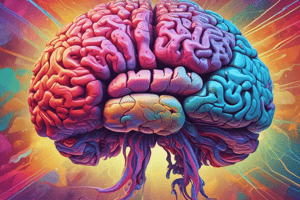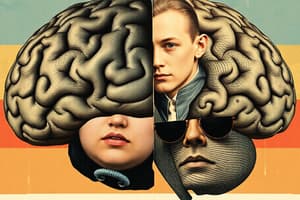Podcast
Questions and Answers
Match the following brain lobes with their primary functions:
Match the following brain lobes with their primary functions:
Frontal lobe = Planning, decision-making, and problem-solving Parietal lobe = Processing sensory information from the body, such as touch and pain Temporal lobe = Auditory processing, language comprehension, and memory Occipital lobe = Visual processing
Match the following brain areas with their associated functions:
Match the following brain areas with their associated functions:
Motor cortex = Controls voluntary movements of the body Broca's area = Speech production Wernicke's area = Language comprehension Somatosensory cortex = Processes sensory information from the body
Match the following brain lobes with their associated sensory experiences:
Match the following brain lobes with their associated sensory experiences:
Parietal lobe = Touch, temperature, and pain Temporal lobe = Auditory information Occipital lobe = Visual information Frontal lobe = None directly; involved in interpreting and responding to sensory input
Match the following brain lobes with their associated cognitive functions:
Match the following brain lobes with their associated cognitive functions:
Match the following brain structures with their associated lobes:
Match the following brain structures with their associated lobes:
Match the following functions with their associated brain lobes:
Match the following functions with their associated brain lobes:
Match the following brain lobes with their associated areas:
Match the following brain lobes with their associated areas:
Flashcards
Four Lobes of the Brain
Four Lobes of the Brain
The brain's largest part, divided into frontal, parietal, temporal, and occipital lobes.
Frontal Lobe
Frontal Lobe
Located at the front, it's responsible for higher-level functions like planning and decision-making.
Motor Cortex
Motor Cortex
Part of the frontal lobe that controls voluntary movements of the body.
Parietal Lobe
Parietal Lobe
Signup and view all the flashcards
Temporal Lobe
Temporal Lobe
Signup and view all the flashcards
Wernicke's Area
Wernicke's Area
Signup and view all the flashcards
Occipital Lobe
Occipital Lobe
Signup and view all the flashcards
Interconnected Lobes
Interconnected Lobes
Signup and view all the flashcards
Study Notes
The Four Lobes of the Brain
- The cerebrum, the largest part of the brain, is divided into four lobes: frontal, parietal, temporal, and occipital.
- Each lobe is responsible for specific functions, and they work together to process information and control body functions.
Frontal Lobe
- Located at the front of the brain, the frontal lobe is associated with higher-level cognitive functions.
- Executive functions, such as planning, decision-making, and problem-solving, are primarily housed here.
- Also involved in voluntary movement, speech production (Broca's area), and personality.
- Contains the motor cortex, which controls voluntary movements of the body.
Parietal Lobe
- Situated behind the frontal lobe, the parietal lobe processes sensory information from the body, such as touch, temperature, and pain.
- It plays a crucial role in spatial awareness, navigation, and understanding of numbers and their magnitude.
- Also involved in processing sensory information related to taste and texture.
Temporal Lobe
- Located on either side of the head, above the ears, the temporal lobes handle auditory processing.
- Critical for understanding language, memory (particularly long term memory), and object recognition.
- Contains Wernicke's area, important in language comprehension.
- Also involved in processing visual information related to facial recognition.
Occipital Lobe
- Located at the back of the brain, the occipital lobe is solely dedicated to visual processing.
- It receives and interprets visual information from the eyes.
- Different areas within the occipital lobe specialize in processing different aspects of vision, like color, shape, and motion.
Interconnections and Integration
- The four lobes are highly interconnected. They don't function in isolation but communicate with each other to perform complex tasks.
- Information is relayed between lobes to allow for a comprehensive understanding of the world.
- Damage to one area can affect other areas and functions.
Studying That Suits You
Use AI to generate personalized quizzes and flashcards to suit your learning preferences.




